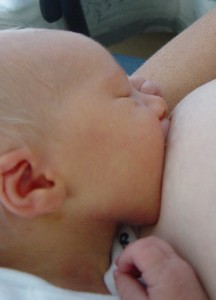Breastfeeding – What to expect (Part 2)
Breastfeeds are likely to occur in several phases or instalments to achieve ‘satiety’ – baby feeling satisfied. When a mother’s milk first ‘comes in’ baby may be full and satisfied in one session or phase at the breast as his stomach capacity has to stretch to accommodate the bigger volume of milk taken during the feed. Over the next day or so this will gradually change and baby will begin to seek a second session or phase of each feed, and sometimes, perhaps, a third! Typically, baby will start the feed enthusiastically gulping down the fast-flowing milk from the full breast. This first phase of the feed may be completed in quite a short time, maybe 5-10 minutes. Baby will appear fully satisfied and will often drop off to sleep. The milk baby has taken during this first phase of the feed is likely to be ‘foremilk’ which is full of wonderful nutrients but has very little fat content. Baby will sleep a short time – maybe up to 30 minutes, and then stir. He has partially digested the foremilk and now “cues” to complete the breastfeed. It is advisable to return the baby to the same breast he fed from first, and the milk he takes in the second phase of the feed is likely to be milk which is higher in fat – called ‘hindmilk’. This fattier milk will be digested more slowly than the foremilk and help keep baby satisfied until he is ready for the next breastfeed. He may even repeat this a third or fourth time at some feeds. So the message is: Return baby to the starting breast at least once, before offering the second breast. Baby will let you know when he has had enough – he will simply “self-release” from the breast and relax. At the next breastfeed the mother can offer the opposite breast, following the baby’s cues as above. This pattern ensures both breasts are well drained a number of times during each 24 hour period, enhancing the establishment of an ample breastmilk supply. As baby grows he may drain the first breast in a couple of phases and still want more, so the feed may need to be completed on the second breast. In this case start the next feed on the breast which was drained the least – probably the second breast. So each breastfeed is usually comprised of a few installments. Just as an adult varies the size of meals eaten according to hunger, and meals may be comprised of several courses, babies vary their feeds too. Young babies particularly need to take each ‘meal’ in a few stages, with rest times in between each stage to allow comfortable digestion. Some feeds will be completed in less time and fewer instalments according to baby’s needs. Mothers should be flexible, and by responding to baby’s feeding cues he will be satisfied, contented and thrive, and sleep well between feeds. Mothers should also be prepared for baby to change his pattern of feeding from time to time. This usually coincides with a growth phase or developmental period, and baby will demand feeds more frequently for a few days. To facilitate the process of adjusting the mother’s milk supply whatever plans were made for that day may need to be abandoned, and ‘just feed the baby’. The mother’s body will respond by increasing her milk supply within 24-48 hours. But wait, there’s more to this process! These growth phases are not simply about increasing milk volumes taken by baby. The constituents of the mother’s breastmilk will also change to suit the growing baby’s changing nutritional requirements. How this happens is still not fully understood, but nature provides perfectly for growing babies. Mothers can trust their babies to guide them to know when, and how long they need to feed. Scheduled feeding disables and disempowers this intuitive communication between mother and baby. So forget the clock!



